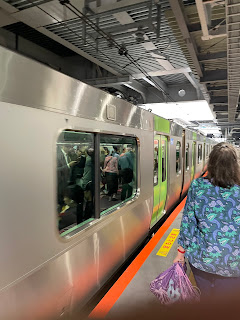After a rather odd assortment of breakfast dishes, including lettuce salad and beef curry over rice, among other selections, we gathered in the lobby, put our shoes back on, and got on the bus for a drive to Lake Ashi.
This volcanic lake, in a caldera on the side of Mt. Hakone, is more than three miles long and very deep. We had the boat almost to ourselves, with very few other passengers. Probably because holiday vacationers do not get up early in the morning.
In this area, at higher altitude, there are still a few cherry trees in blossom. We enjoyed getting the chance to see them this late in the season.
The bus met us at another dock, farther down the lakeshore, and drove us to Hakone town where we visited the Hamamatsuya woodworking shop. The owner, a fourth or fifth-generation craftsman, gave a fascinating demonstration of how they create intricate patterns in wood to create all sorts of unexpected things.
Mary purchased some very neat wooden jewelry. We saw lots of other interesting items, but none intriguing enough to bring home.
From the wood shop we drove on to one of the tourist hotels in town (that is quite a bit newer and fancier than the one in which we are staying) where we enjoyed a "shabu-shabu" lunch.
Each of us had a box of assorted meats and vegetables, and we shared a bowl of boiling water over a butane burner. We cooked our food in the hot-pot and seasoned it to taste with a variety of spices and sauces provided.
It was a very good meal, but quite messy. We left the table in chaos for the bus boys to clean up! And when we went to use the restroom, it was the first time we encountered "bathroom shoes." You are supposed to take your shoes off at the door and wear special shoes to the toilet so as not to carry dirt from the toilet out into the world. We all cheated.
The hotel featured a very beautiful, traditional Japanese garden outside the main lobby. We delayed the bus departure by going out to take photos of it.
The bus transported us a short distance to another hotel (also quite a bit newer and fancier than the one in which we are staying) where we met in a private conference room (without a strict 60 minute limit) for a conversation with two Geisha.
These were not "Geisha Girls." One was the okaasan or "mother" of an okiya or "house." She was probably in her late 70s or perhaps 80. The other became a maiko or apprentice geisha after graduating from university 25 years ago. So she was in her late 40s.
We had a full hour to hear about what these women do for a living and to ask all sorts of questions. It was a lively conversation. Geisha are entertainers and exemplars of the ideal Japanese woman (or at least the male fantasy of that ideal).
But the role is changing, and sometimes clients include women who wish to be entertained by traditional Japanese music, dance, and poetry. After the discussion, the Geishas performed some traditional dances and sang for us. The older woman has a rather remarkable voice, especially for her age.
Our tour leader told us that she does not have this kind of discussion opportunity when leading tours for other companies. It's another feature unique to OAT.
On the way back to the hotel, the bus dropped seven or eight of us off at the Hakone Open-Air Museum.This is a privately operated sculpture garden. Our expectations were low. But this is a very large park filled with extraordinary sculptures, from the very traditional to the ultra-modern.
We were very impressed by the variety and quality of the artwork in this outdoor museum. There was even a sculpture designed as a unique play area for children. No adults allowed!
Our tour leader, Mariko, navigated us back to the hotel, first by train, then by a funicular that took us up the mountain, and finally by a 10-minute walk. Our transit cards from Tokyo worked flawlessly here, as well.
The group met informally for drinks and snacks before dinner. By happenstance, dinner at this hotel tonight was also a shabu-shabu, very similar to what we had at lunch. There were enough differences, however, that we enjoyed the evening meal, as well.

















































